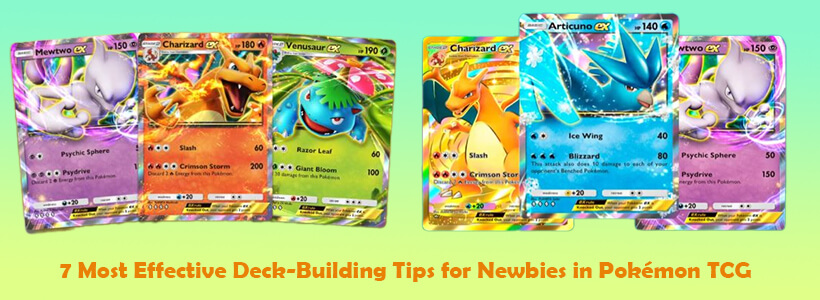In the world of Pokémon TCG (Trading Card Game), the most important thing to achieve success is to find the right way to build the most effective deck. Especially for beginners, when unfamiliar with the combo mechanism, battle rhythm, or resource optimization, creating a reasonable deck is the key to getting closer to the first victories. In this article, we will provide you with the 7 most effective Pokémon TCG deck-building strategy tips specifically for beginners.
1. Choose the main Pokémon as the core strategy
When starting to build a deck, the first thing to do is to choose a main Pokémon. This will be the center of all your attack and defense strategies. For beginners, choosing Legendary Pokémon such as Arceus VSTAR, Mew VMAX, or Zacian V is a smart direction. These Pokémon have powerful skill systems, are easy to use, and have low energy moves to maximize their effectiveness. My advice is to choose Pokémon with high HP (210 or higher) and attacks that require at least 2-3 energy to activate. This will help you avoid losing your rhythm in the first few turns when the match is tense.
2. Don’t keep too many cards
A common mistake among beginners is to want to cram as many strong Pokémon as possible into the deck. This is a fatal mistake! An effective deck should usually only have 12 to 18 Pokémon, revolving around the main Pokémon and necessary support Pokémon. For example, if you build a deck around Lugia VSTAR, you only need to add Archeops to support energy charging and a few secondary Pokémon like Lumineon V to find Supporters. Make sure the ratio: 70% of the Pokémon in the deck must be closely linked to the main strategy, not rambling, not scattered.
3. Maintain enough energy, not too much
Many beginners often think that the more energy, the better. A standard deck only needs 10 to 14 Energy cards, depending on the strategy. If your main Pokémon needs 2 or 3 energies to attack, prioritize quick energy by taking advantage of Trainers like Professor’s Research or Abilities like Starbirth (from Arceus VSTAR). Don’t forget to calculate the type of energy needed: if you build a Dragon deck like Rayquaza VMAX, you will need to alternate between Fire and Electric energy – so don’t just hold on to Dragon-type Basic Energy!
4. Trainer Cards – the secret to a good deck
Trainer Cards (including Supporter, Item, and Stadium) are the lifeblood of a TCG deck. An average strong deck needs 30–35 Trainer cards. Supporters help you draw cards quickly (eg Professor’s Research, Boss’s Orders), Items help you find Pokémon, get energy (Quick Ball, Ultra Ball, Evolution Incense), and Stadium creates field advantage (Path to the Peak, Collapsed Stadium). Remember, for beginners, prioritize 4 Professor’s Research cards to ensure the fastest resource draw. Decks that draw cards well will win 80% of all matches.
5. Build an optimized “combo”
In Pokémon TCG, combos are not as complicated as you think. A good deck only needs 2 to 3 small combos linked together. For example, Lugia VSTAR + Archeops → Summoning Star brings Archeops onto the field → Archeops uses Primal Turbo to charge up Lugia VSTAR or another attacking Pokémon. Similarly, Mew VMAX can use Genesect V to draw cards super-fast with the Ability Fusion Strike System, and quickly activate Cross Fusion Strike by choosing the appropriate move. Focus on building simple 2-step combos, instead of embracing complex 5-6-step chains that are easy to get confused and lose easily.
6. Build decks according to Meta – always update
Even if you are new to the game, take the time to refer to major tournaments such as Pokémon World Championships or Regional Championships. Observe which decks are winning the most: Arceus VSTAR Combo, Mew VMAX Aggro, Lugia Turbo, … From there, you can copy the basic building and customize it accordingly. If you build it yourself, think simply: The deck must be faster, stronger, and more stable than your opponent. The fastest way to improve is to copy and improve based on the current meta decks.
7. Practice in real battles
Even if a deck is perfect on paper, it is not certain to win the match if you do not practice. For each new deck build, you should play at least 30 test matches (both online and offline) to test: card drawing speed, ability to survive under pressure, ability to clear the field, and handle bad situations (e.g. Stadium destroyed, lack of energy). Note the weak points of the deck and continuously adjust: add 1 new Stadium, remove 1 extra Pokémon, and change the Supporter ratio. This process is the step that turns you from a “newbie” to a “real TCG player”.
Building an effective Pokémon TCG deck is not just about arranging cards, but the art of balancing power, speed, and strategy. For beginners, if you master the basic principles: choosing simple main Pokémon, neat combos, smart energy management, and optimizing Trainers, you have already gone 80% of the way to success. Don’t be afraid of mistakes in the first matches – every wrong card drawn, and every failed combo is a valuable lesson to help you improve. Remember, every champion was once a beginner. It is perseverance, creativity, and passion that are the ultimate weapons in the world of Pokémon TCG!
